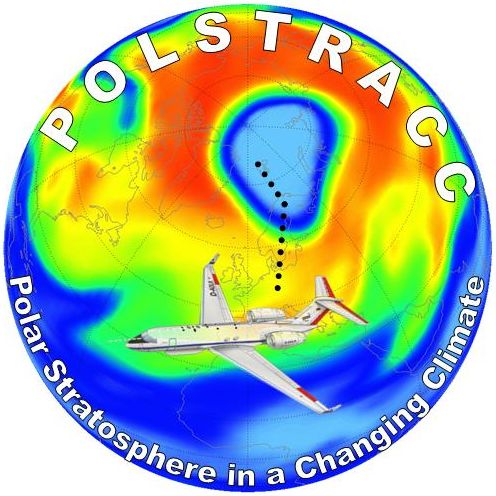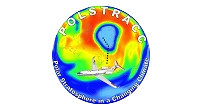POLSTRACC: Difference between revisions
No edit summary |
No edit summary |
||
| Line 2: | Line 2: | ||
The HALO (High Altitude and LOng Range Research Aircraft) mission POLSTRACC aims on providing new scientific knowledge on the structure, composition and evolution of the Arctic Upper Stratosphere/Lower Stratosphere region (UTLS) in a changing climate. In contrast to previous aircraft campaigns, special focus is set on the investigation of the Lowermost Stratosphere (LMS) and Tropopause Region, which is important for the atmospheric radiation budget and the climate system. |
The HALO (High Altitude and LOng Range Research Aircraft) mission POLSTRACC aims on providing new scientific knowledge on the structure, composition and evolution of the Arctic Upper Stratosphere/Lower Stratosphere region (UTLS) in a changing climate. In contrast to previous aircraft campaigns, special focus is set on the investigation of the Lowermost Stratosphere (LMS) and Tropopause Region, which is important for the atmospheric radiation budget and the climate system. Important aspects adressed by POLSTRACC are a detailed characterisation of the Arctic winter LMS, the impact of the polar vortex outflow on the midlatitude LMS, the role of cirrus clouds in the Arctic UTLS region as well as the impact of gravitiy waves in this region. Furthermore, the investigation of polar stratospheric clouds, related chemical and microphysical processes as well as the role of halogen chemistry in the UTLS region are covered by the objectives of POLSTRACC. |
||
| ⚫ | |||
Key issues adressed by POLSTRACC are the investigation of: |
|||
| ⚫ | |||
* The structure of Arctic LMS: How large are the contributions of (ii) polar vortex air, (ii) extra-vortex stratospheric air and (iii) tropospheric air? |
|||
* The outflow of the polar vortex: How much vortex air descends through the bottom of the polar vortex during the course of the winter? To which extend are the chemical composition and the radiative balance of the surrounding LMS and the adjacent tropopause region affected? How efficient are stratosphere-troposphere exchange processes in the Arctic? |
|||
* Arctic cirrus clouds: To which extend do cirrus clouds around the Arctic tropopause and LMS region disturb chemical budgets (especially ozone) through heterogeneous reactions? Which role do cirrus clouds play in chlorine activation? How are the the budgets of water vapour and reactive nitrogen are affected by dehydration and denitrification through cirrus cloud particles? |
|||
* Polar stratospheric clouds (PSCs): How deep do polar stratospheric clouds pentrate into the lower stratosphere region? How strong is the LMS region disturbed by renitrification of nitric acid trihydrate (NAT) particles? How strong is the linkage between the occurence of PSCs and tropospheric clouds? |
|||
* Gravity waves: How do gravity waves affect the stability of the Arctic polar vortex? |
|||
* Role of the Arctic LMS and tropopause region in climate: How sensitive is the climate to changes in the chemical composition of this region? What are the dominant processes affecting ozone in this vertical range? How will the extent of Arctic cirrus cloud and PSC formation evolve in future and what are the consequences? |
|||
POLSTRACC will use a payload of remote-sensing and in-situ instruments for a variety of trace species with contributions from institutes of the Helmholtz Association, the Max-Planck Society, and universities. We plan to cut the mission into two parts, a test campaign with the full payload in December probing the early polar vortex, and an extened deployment in January/March of the following year, covering the evolution of the polar vortex during winter and spring. |
The POLSTRACC mission will use a payload of remote-sensing and in-situ instruments for a variety of trace species with contributions from institutes of the Helmholtz Association, the Max-Planck Society, and universities. We plan to cut the mission into two parts, a test campaign with the full payload in December probing the early polar vortex, and an extened deployment in January/March of the following year, covering the evolution of the polar vortex during winter and spring. |
||
The test flights into the early vortex will be carried out from Oberpfaffenhofen, Germany. The winter campaign will be based in at Kiruna Airport (68°N), allowing deep penetration of the polar vortex and sampling the interface region to the surrouding stratosphere including vortex streamers and filaments in the vicinity of the polar vortex. |
The test flights into the early vortex will be carried out from Oberpfaffenhofen, Germany. The winter campaign will be based in at Kiruna Airport (68°N), allowing deep penetration of the polar vortex and sampling the interface region to the surrouding stratosphere including vortex streamers and filaments in the vicinity of the polar vortex. |
||
Revision as of 18:17, 11 July 2013
The Polar Stratosphere in a Changing Climate
The HALO (High Altitude and LOng Range Research Aircraft) mission POLSTRACC aims on providing new scientific knowledge on the structure, composition and evolution of the Arctic Upper Stratosphere/Lower Stratosphere region (UTLS) in a changing climate. In contrast to previous aircraft campaigns, special focus is set on the investigation of the Lowermost Stratosphere (LMS) and Tropopause Region, which is important for the atmospheric radiation budget and the climate system. Important aspects adressed by POLSTRACC are a detailed characterisation of the Arctic winter LMS, the impact of the polar vortex outflow on the midlatitude LMS, the role of cirrus clouds in the Arctic UTLS region as well as the impact of gravitiy waves in this region. Furthermore, the investigation of polar stratospheric clouds, related chemical and microphysical processes as well as the role of halogen chemistry in the UTLS region are covered by the objectives of POLSTRACC.
The POLSTRACC mission will use a payload of remote-sensing and in-situ instruments for a variety of trace species with contributions from institutes of the Helmholtz Association, the Max-Planck Society, and universities. We plan to cut the mission into two parts, a test campaign with the full payload in December probing the early polar vortex, and an extened deployment in January/March of the following year, covering the evolution of the polar vortex during winter and spring.
The test flights into the early vortex will be carried out from Oberpfaffenhofen, Germany. The winter campaign will be based in at Kiruna Airport (68°N), allowing deep penetration of the polar vortex and sampling the interface region to the surrouding stratosphere including vortex streamers and filaments in the vicinity of the polar vortex.

